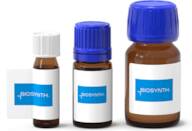
Glucagon (1-29), bovine, human, porcine
CAS : 16941-32-5
Ref. 3D-PG16975
| 1mg | 433,00 € | ||
| 10mg | 485,00 € | ||
| 100mg | 1.008,00 € |
Informations sur le produit
- H-HSQGTFTSDYSKYLDSRRAQDFVQWLMNT-OH
- Glucagon (1-29) (human, bovine, porcine)
- Glucagon, human recombinant
- H-His-Ser-Gln-Gly-Thr-Phe-Thr-Ser-Asp-Tyr-Ser-Lys-Tyr-Leu-Asp-Ser-Arg-Arg-Ala-Gln-Asp-Phe-Val-Gln-Trp-Leu-Met-Asn-Thr-OH
- L-histidyl-L-seryl-L-glutaminylglycyl-L-threonyl-L-phenylalanyl-L-threonyl-L-seryl-L-alpha-aspartyl-L-tyrosyl-L-seryl-L-lysyl-L-tyrosyl-L-leucyl-L-alpha-aspartyl-L-seryl-L-arginyl-L-arginyl-L-alanyl-L-glutaminyl-L-alpha-aspartyl-L-phenylalanyl-L-valyl-L-glutaminyl-L-tryptophyl-L-leucyl-L-methionyl-L-asparaginyl-L-threonine
- Glucagon Hydrochloride(Human)
Glucagon (1-29) - Human, Porcine (CAS: 16941-32-5)
SB-PEPTIDE offers glucagon 1-29 peptide HSQGTFTSDYSKYLDSRRAQDFVQWLMNT for research on diabetes, obesity, and non-alcoholic fatty liver disease (NAFLD).
G-Protein Coupled Receptor
Glucagon operates through the GPCR signaling pathway, which plays a pivotal role in cellular communication. This type of receptors are known as seven-transmembrane domain receptors, which possess a unique structure that enables them to detect external molecules and activate cellular responses. Their vital association with G proteins fuels a cascade of events, initiating a cellular symphony, orchestrated by two principal signal transduction pathways: the cAMP signal pathway and the phosphatidylinositol signal pathway.
Glucagon class B GPCR receptor - Glucagon peptide CAS: 16941-32-5
Glucagon class B GPCR 3D structure
Glucagon receptor/class B GPCR
GPCR superfamily is organized into three main classes, among which the secretin receptor family (class B) regulated by glucagon peptides.
Glucagon receptor is a 62 kDa plasma membrane protein activated upon binding to glucagon. When HSQGTFTSDYSKYLDSRRAQDFVQWLMNT binds to its receptor, conformational changes occur, which leads to the activation of G proteins. This activation sets off a cascade of events, including adenylate cyclase activation and subsequent cyclic AMP (cAMP) production. The cellular response is further orchestrated by protein kinase A, initiating series of biochemical reactions.
Thanks to previous studies, it is known that glucagon receptors are predominantly present in the liver and kidneys, with varying expressions in other vital organs. Interestingly, the way glucagon works in diabetes, obesity, and NAFLD has led to new areas of investigation, suggesting its potential use as therapeutic target.
Glucagon(1-29) glucoregulatory peptide hormone
Thanks to its ability to stimulate hepatic glucose production, modulate energy balance, and potentially influence appetite regulation, glucagon 1-29 glucoregulatory peptide (CAS: 16941-32-5) represents a new powerful and versatile tool in driving scientific progress. It’s implication in various realms, ranging from the treatment of severe insulin-induced hypoglycemia to potentially addressing obesity and NAFLD, opens doors to innovative therapeutic avenues.
Let SB-PEPTIDE give you the compass to guide you toward new groundbreaking advancements in medical science. Ask for a quote in one click on this webpage’s upper right button.
For research use only
Propriétés chimiques
Question d’ordre technique sur : 3D-PG16975 Glucagon (1-29), bovine, human, porcine
Si vous souhaitez demander un devis ou passer commande, veuillez plutôt ajouter les produits souhaités à votre panier, puis demander un devis ou passer commande à partir de votre panier. C'est une méthode plus rapide, plus économique, et vous pourrez bénéficier des remises disponibles ainsi que d'autres avantages





